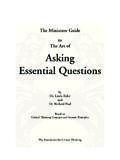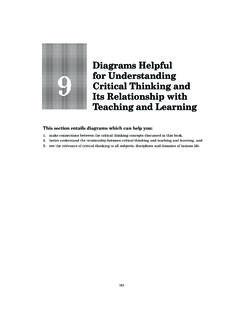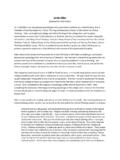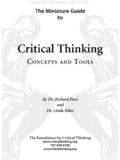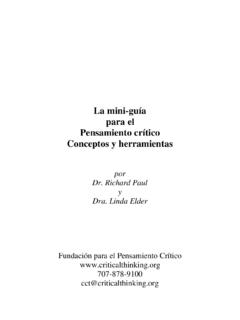Transcription of Engineering Reasoning - Critical thinking
1 The Thinker s Guide to Dr. Richard Paul Dr. Robert Niewoehner Dr. Linda ElderThe Foundation for Critical ThinkingEngineering ReasoningBased on Critical thinking Concepts & Tools 2006 Foundation for Critical thinking Thinker s Guide to Engineering Reasoning ForewordI am delighted to recommend The Thinker s Guide to Engineering Reasoning for engineer-ing instructors, students, and engineers alike. This guide is a very useful addition to the arsenal of Engineering education tools. I believe it fills a gap that has been largely ignored in Engineering instruction.
2 It covers an important area of competence that we so often presume students will acquire, but traditionally (and sadly) do not sufficiently address, if at all. An isolated focus on technical skill delivery, or on one skill area, has not worked in the past, currently fails and will not meet tomorrow s needs. It is important for the field of Engineering to be understood as systems of overlapping and interrelated ideas, rather than isolated and different fields of knowledge. Moreover, it is important to recognize and effectively deal with the multiple environmental, social and ethical aspects that complicate responsible Engineering .
3 Accordingly, it is time for Engineering educators to realize that effective Engineering instruction cannot be based in memorization or technical calculation alone. Rather, it is essential that Engineering students develop the generalizable Critical thinking skills and dispositions necessary for effectively and professionally Reasoning through the complex Engineering issues and questions they will face as engineers. The authors outline and detail these skills and dispositions quite effectively in this am further delighted to note the level of detailed sub distinctions covered in the guide.
4 I believe it is Dave Merrill who originally claimed that expertise is defined by the number of detailed sub-divisions clearly made and qualified. As such, the authors have proven mastery!Growing industry dissatisfaction with deficient Engineering education has led to the inception of the CDIO Initiative. This international design addresses Engineering educa-tion reform in its broader context. Active student participation forms an integral part of this solution. While not the exclusive aim or application of this guide, its potential to com-pliment such institutional reforms by equipping the student to step up to the challenges of independent Reasoning , is particularly beneficial.
5 The Thinkers Guide to Engineering Reasoning is not only a must-read publication for Engineering educators, but a vital guide and career long companion for students and engineers AB Steyn University of PretoriaSouth AfricaMay 2006 2006 Foundation for Critical thinking The Thinker s Guide to Engineering ReasoningContentsForeword 1 Introduction
6 3A Model of Engineering Reasoning 4In tellectual Traits Essential to Engineering Reasoning 6 Universal Structures of Thought 9A Checklist for Engineering Reasoning 10 The Spirit of Critical thinking
7 11 Analyzing an Engineering Document 12 Analyzing a Design Using the Elements of Thought 14 Two Kinds of Engineering Questions 16 Analyzing Disciplines: Aerospace Engineering 17 Analyzing Disciplines: Electrical Engineering 18 Analyzing Disciplines.
8 Mechanical Engineering 19 Analyzing Engineering Tools: Modeling and Simulation 20 Engineering Reasoning Uses Intellectual Standards 21 Design Evaluation Questions Targeting Intellectual Standards 25 Using Intellectual Standards to Assess Graphics
9 26 Evaluating an Engineer s or Author s Reasoning 28 Analyzing and Assessing Engineering Research 30 Recognizing Skilled and Unskilled Reasoning 31 The Questioning Mind in Engineering .
10 The Wright Brothers 39 The Cost of thinking Gone Awry 41 Noteworthy Connections and Distinctions 42Et hics and Engineering 44 The Problem of Egocentric thinking 46 Engineering Reasoning Objectives
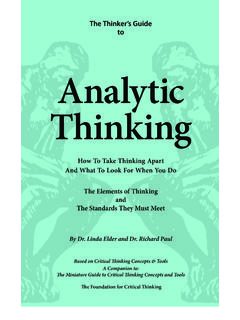
![riChard Paul [ ] - Critical thinking](/cache/preview/4/4/e/4/c/a/a/a/thumb-44e4caaa8aace41cbe216a7e608396cc.jpg)

